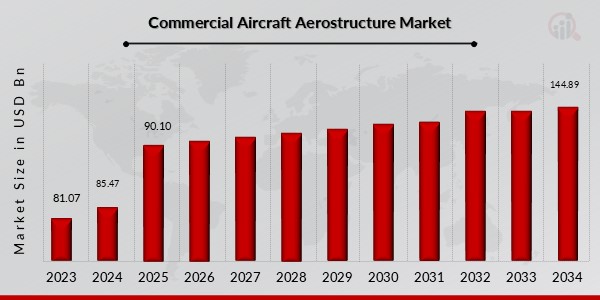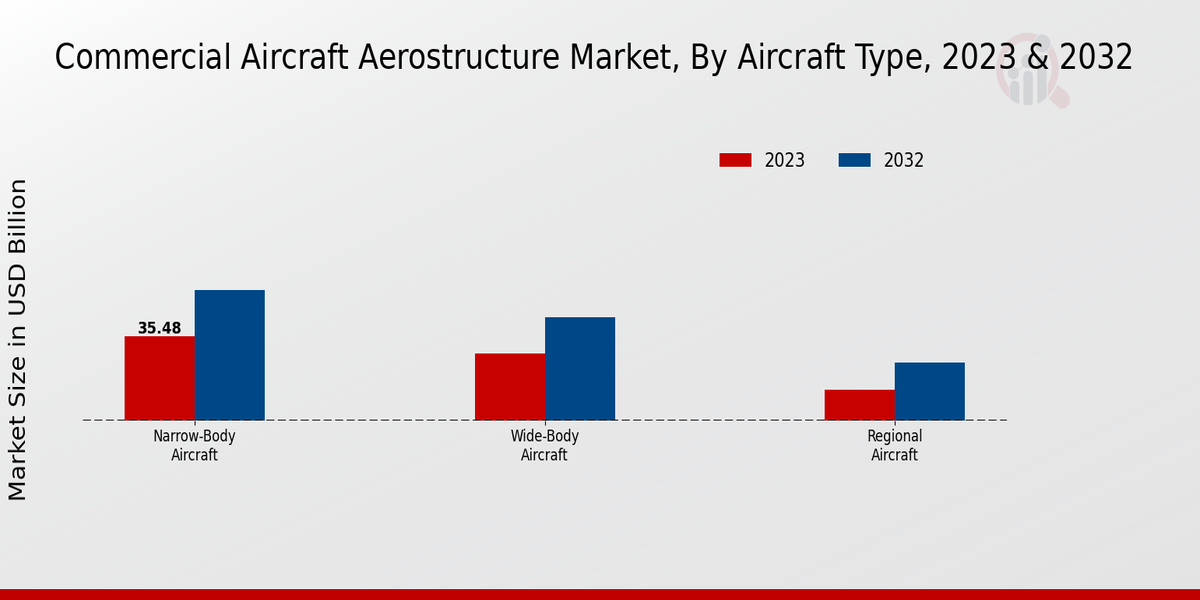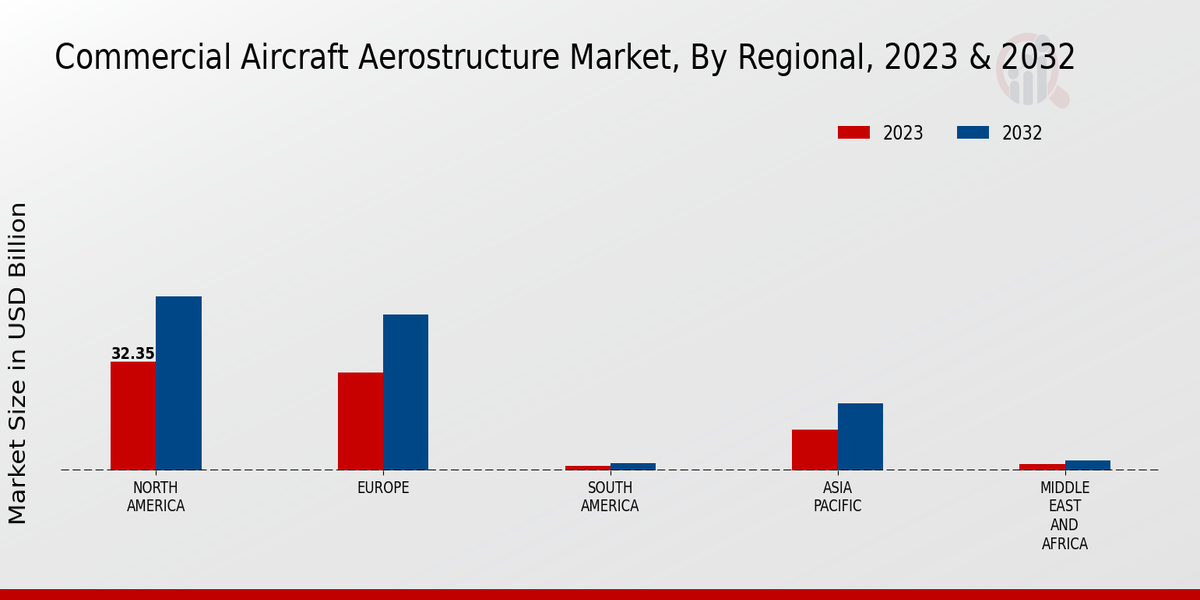Global Commercial Aircraft Aerostructure Market Overview
Commercial Aircraft Aerostructure Market Size was estimated at 85.47 (USD Billion) in 2024. The Commercial Aircraft Aerostructure Market Industry is expected to grow from 90.10 (USD Billion) in 2025 to 144.89 (USD Billion) by 2034. The Commercial Aircraft Aerostructure Market CAGR (growth rate) is expected to be around 5.4% during the forecast period (2024 - 2035).

Source Primary Research, Secondary Research, MRFR Database and Analyst Review
Key Commercial Aircraft Aerostructure Market Trends Highlighted
The commercial aircraft aerostructure market is primarily driven by the growing demand for new commercial aircraft, particularly in emerging markets. Increasing air travel, the replacement of aging aircraft fleets, and the expansion of low-cost carriers are contributing to the market's growth. Additionally, the focus on improving fuel efficiency and reducing operating costs is driving demand for lightweight, aerodynamic aerostructures.Emerging technologies, such as additive manufacturing and advanced materials, provide opportunities for innovation and cost-reduction in aerostructure production. The integration of composite materials, which offer superior strength-to-weight ratios, is becoming increasingly important. Furthermore, the growth of unmanned aerial vehicles (UAVs) creates new opportunities for specialized aerostructures.One notable trend is the increasing adoption of advanced materials, including composites and titanium alloys, which offer improved mechanical properties and weight reduction. Another trend is the automation of manufacturing processes to enhance efficiency and quality. Additionally, the development of modular aerostructures, which can be easily assembled and disassembled, is gaining traction to reduce maintenance costs and improve flexibility.
Commercial Aircraft Aerostructure Market Drivers
Increasing Demand for Air Travel
The major driver of the commercial aircraft aerostructure market is the demand for air travel. The growth of the number of air passengers has been steadily increasing over the past few years, and this trend is expected to continue in the future. There are several factors that have been causing the growth of air travel, among them the increase of the average salary and economic growth, the rise of urbanized population and low-cost airline expansions.The growing demand for air travel causes an increase in demand for commercial aircraft and, therefore, for aerostructures, which are the main components of an aircraft. Another factor driving the market is the growth of demand for air travel in emerging markets such as China and India. These countries are experiencing rapid economic growth, and an increasing number of people are getting higher salaries and can afford to buy an airline ticket.The same growth of air travel can be observed in other emerging markets, and this trend will likely continue in the future, and the demand for commercial aircraft and aerostructures will continue growing. Apart from the increasing demand for air travel, the other factors that drive the commercial aircraft aerostructure market include the replacement demand for old commercial aircraft with new ones, the development of new aircraft designs and technologies, the use of new materials, such as composite materials in the construction of aircraft, demand for more fuel-efficient aircraft, and others All these factors drive the growth of the commercial aircraft aerostructure market, and it will keep growing in the future.
Technological Advancements
The commercial aircraft aerostructure market is also being driven by a number of technological advancements. These advancements are leading to the development of lighter, stronger, and more fuel-efficient aircraft. This, in turn, is making air travel more affordable and accessible. One of the most significant technological advancements in recent years is the development of composite materials. Composite materials are lighter and stronger than traditional materials, such as aluminum and steel.This makes them ideal for use in aircraft construction, as they can help to reduce the weight of the aircraft and improve its fuel efficiency. Another significant technological advancement is the development of new aircraft design concepts. These new concepts are designed to improve the aerodynamic efficiency of aircraft, which can also lead to improved fuel efficiency. These technological advancements are all contributing to the growth of the commercial aircraft aerostructure market.As these technologies continue to develop, the market is expected to continue to grow in the coming years.
Government Regulations
Another factor that is likely to impact the growth of the commercial aircraft aerostructure market is government regulations. These regulations are designed to improve the safety and environmental performance of aircraft. In particular, several government regulations have been introduced in recent years to improve the fuel efficiency of aircraft. This is allowing airlines to reduce the amount of fuel they consume. Many other government regulations have also been introduced to improve the safety of aircraft.These regulations are leading to the adoption of new materials and the development of new technologies. All of these government regulations are likely to impact the growth of the commercial aircraft aerostructure market. As these regulations continue to change, the commercial aircraft aerostructure market is likely to expand in the coming years.
Commercial Aircraft Aerostructure Market Segment InsightsCommercial Aircraft Aerostructure Market Aircraft Type Insights
The Commercial Aircraft Aerostructure Market is segmented by Aircraft Type into Narrow-body Aircraft, Wide-body Aircraft, and Regional Aircraft. The Narrow-body Aircraft segment held the largest market share in 2023, owing to the increasing demand for single-aisle aircraft for short- and medium-haul flights. The Wide-body Aircraft segment is projected to grow at a significant CAGR during the forecast period, driven by the rising demand for long-haul flights and the increasing number of wide-body aircraft orders from major airlines.The Regional Aircraft segment is anticipated to witness steady growth, attributed to the increasing demand for regional connectivity and the growing popularity of turboprop aircraft. In 2023, the Narrow-body Aircraft segment was estimated to account for approximately USD 35.48 billion in revenue, while the Wide-body Aircraft segment is projected to generate around USD 28.34 billion. The Regional Aircraft segment is expected to contribute approximately USD 13.07 billion to the Commercial Aircraft Aerostructure Market revenue in 2023. By 2032, the Narrow-body Aircraft segment is anticipated to reach a valuation of USD 55.36 billion, while the Wide-body Aircraft segment is projected to grow to USD 43.68 billion.The Regional Aircraft segment is expected to reach a value of USD 24.36 billion by 2032. The growth of the Commercial Aircraft Aerostructure Market is primarily attributed to the increasing air passenger traffic, rising demand for new aircraft, and the need for efficient and lightweight aerostructures. The market is further driven by technological advancements, such as the adoption of composite materials and additive manufacturing, which offer improved structural performance and reduced weigh
t
Source Primary Research, Secondary Research, MRFR Database and Analyst Review
Commercial Aircraft Aerostructure Market Material Insights
The Commercial Aircraft Aerostructure Market is segmented into various materials, including Aluminum Alloys, Composite Materials, Titanium Alloys, and Steel. Each material type offers unique properties and characteristics that cater to specific aircraft design requirements. Aluminum Alloys Aluminum alloys are widely used in aircraft aerostructures due to their high strength-to-weight ratio, corrosion resistance, and affordability. They are commonly employed in fuselage panels, wing skins, and other structural components. The Commercial Aircraft Aerostructure Market revenue for Aluminum Alloys is expected to grow from USD 26.4 billion in 2023 to USD 37.2 billion by 2032, exhibiting a CAGR of 4.2%.Composite Materials Composite materials, such as carbon fiber-reinforced polymers (CFRP) and glass fiber-reinforced polymers (GFRP), are gaining prominence in aircraft aerostructures due to their exceptional strength, lightweight, and durability. They are increasingly used in primary structures like wings, fuselages, and empennages. The Commercial Aircraft Aerostructure Market data shows that the Composite Materials segment is projected to witness significant growth, reaching USD 42.6 billion by 2032, with a CAGR of 6.1%. Titanium Alloys Titanium alloys offer high strength, low weight, and excellent corrosion resistance, making them suitable for critical aircraft components such as landing gear, engine mounts, and firewall structures.The Commercial Aircraft Aerostructure Market Statistics indicate that the Titanium Alloys segment is anticipated to reach USD 16.7 billion by 2032, growing at a CAGR of 4.8%. Steel. Steel is primarily used in aircraft aerostructures for high-strength components like landing gear, wing spars, and bulkheads. It provides structural integrity and durability. The Commercial Aircraft Aerostructure Market industry estimates the Steel segment to reach USD 10.3 billion by 2032, expanding at a CAGR of 3.9%.
Commercial Aircraft Aerostructure Market Structural Component Insights
The Structural Component segment of the Commercial Aircraft Aerostructure Market is projected to reach a valuation of USD 34.2 billion by 2024, exhibiting a CAGR of 5.8% during the forecast period. Fuselage accounts for the largest share of the market, driven by the increasing demand for wide-body aircraft and the need for lightweight and fuel-efficient structures. Wings, the second-largest segment, is witnessing significant growth due to the rising adoption of composite materials and advanced manufacturing techniques. Empennage, which includes the vertical and horizontal stabilizers, is expected to grow steadily as aircraft manufacturers focus on improving aerodynamic efficiency.Nacelles, which house aircraft engines, are also expected to experience growth, driven by the increasing popularity of single-aisle aircraft and the need for improved engine performance.
Commercial Aircraft Aerostructure Market Application Insights
The Commercial Aircraft Aerostructure Market is segmented based on application into Passenger Aircraft, Cargo Aircraft, Military Aircraft, and Business Jets. Among these segments, the Passenger Aircraft segment held the largest market share in 2023. The growth of the Passenger Aircraft segment can be attributed to the increasing demand for air travel and the growing number of low-cost carriers. The Cargo Aircraft segment is also expected to witness significant growth over the forecast period owing to the increasing demand for air cargo transportation.The Military Aircraft segment is expected to grow moderately over the forecast period due to the increasing demand for military aircraft from developing countries. The Business Jets segment is expected to witness the highest growth rate over the forecast period due to the increasing demand for private jets from high-net-worth individuals and corporations.
Commercial Aircraft Aerostructure Market Regional Insights
The regional segmentation of the Commercial Aircraft Aerostructure Market offers insights into the performance of the market across different regions. North America is anticipated to contribute significantly to the market revenue, with its well-established aerospace industry and high demand for commercial aircraft. Europe holds a notable share, driven by the presence of major aircraft manufacturers and a strong aftermarket for maintenance, repair, and overhaul (MRO) services. APAC is expected to witness significant growth, fueled by rising air passenger traffic and government initiatives to develop the aviation sector.South America and MEA are projected to have a moderate market presence but are anticipated to exhibit steady growth over the forecast period
.
Source Primary Research, Secondary Research, MRFR Database and Analyst Revie
Commercial Aircraft Aerostructure Market Key Players And Competitive Insights
Major players in the Commercial Aircraft Aerostructure Market industry are constantly striving to gain a competitive edge by investing in research and development of innovative technologies. Leading Commercial Aircraft Aerostructure Market players are focusing on developing lightweight and durable materials to reduce aircraft weight and improve fuel efficiency. They are also exploring the use of advanced manufacturing techniques, such as additive manufacturing, to reduce production costs and lead times. The Commercial Aircraft Aerostructure Market development of new aircraft models by leading manufacturers, such as Boeing and Airbus, is driving demand for aerostructures. These new aircraft models are designed to be more fuel-efficient and have a longer range, which requires the use of advanced aerostructures. The Commercial Aircraft Aerostructure Market Competitive Landscape is expected to remain competitive in the coming years, with leading players continuing to invest in research and development to gain a competitive advantage.Spirit AeroSystems is a leading provider of aerostructures for commercial aircraft. The company has a presence with manufacturing facilities in the United States, Europe, and Asia. Spirit AeroSystems offers a wide range of aerostructures, including fuselages, wings, and nacelles. The company's customers include Boeing, Airbus, and Bombardier. Spirit AeroSystems is investing in research and development to develop new technologies and improve its manufacturing processes. The company is also expanding its presence to meet the growing demand for aerostructures.GKN Aerospace is a leading supplier of aerostructures, engine systems, and services for the aerospace industry. The company has a presence in over 30 countries and employs over 17,000 people. GKN Aerospace's customers include Boeing, Airbus, Bombardier, and Embraer. The company is investing in research and development to develop new technologies and improve its manufacturing processes. GKN Aerospace is also expanding its presence to meet the growing demand for aerostructures.
Key Companies in the Commercial Aircraft Aerostructure Market Include
- Boeing
- Embraer
- IHI Corporation
- Safran
- Airbus
- GKN Aerospace
- Aernnova Aerospace
- Leonardo
- UTC Aerospace Systems
- Kawasaki Heavy Industries
- Spirit AeroSystems
- Triumph Group
- Mitsubishi Heavy Industries
- TAECO
Commercial Aircraft Aerostructure Market Industry Developments
The commercial aircraft aerostructure market is projected to witness steady growth over the next decade, driven by rising demand for new aircraft and increasing adoption of lightweight materials. In 2023, the market size was estimated to be around USD 76.89 billion, which is expected to expand to USD 123.4 billion by 2032, exhibiting a CAGR of 5.4%. Key industry participants are focusing on developing innovative and sustainable solutions to cater to the evolving needs of the aviation sector. For instance, in 2023, Airbus announced the development of a new wing design for its A320neo family of aircraft, which incorporates advanced materials and manufacturing techniques to reduce weight and improve fuel efficiency.
Commercial Aircraft Aerostructure Market Segmentation Insights
Commercial Aircraft Aerostructure Market Aircraft Type Outlook
- Narrow-body Aircraft
- Wide-body Aircraft
- Regional Aircraft
Commercial Aircraft Aerostructure Market Material Outlook
- Aluminum Alloys
- Composite Materials
- Titanium Alloys
- Steel
Commercial Aircraft Aerostructure Market Structural Component Outlook
- Fuselage
- Wings
- Empennage
- Nacelles
Commercial Aircraft Aerostructure Market Application Outlook
- Passenger Aircraft
- Cargo Aircraft
- Military Aircraft
- Business Jets
Commercial Aircraft Aerostructure Market Regional Outlook
- North America
- Europe
- South America
- Asia-Pacific
- Middle East and Africa
Commercial Aircraft Aerostructure Market Report Scope
| Report Attribute/Metric |
Details |
| Market Size 2024 |
85.47(USD Billion) |
| Market Size 2025 |
90.10(USD Billion) |
| Market Size 2034 |
144.89 (USD Billion) |
| Compound Annual Growth Rate (CAGR) |
5.4%(2025 - 2034) |
| Report Coverage |
Revenue Forecast, Competitive Landscape, Growth Factors, and Trends |
| Base Year |
2024 |
| Market Forecast Period |
2025 - 2034 |
| Historical Data |
2021 - 2025 |
| Market Forecast Units |
USD Billion |
| Key Companies Profiled |
Boeing, Embraer, IHI Corporation, Safran, Airbus, GKN Aerospace, Aernnova Aerospace, Leonardo, UTC Aerospace Systems, Kawasaki Heavy Industries, Spirit AeroSystems, Triumph Group, Mitsubishi Heavy Industries, TAECO |
| Segments Covered |
Aircraft Type, Material, Structural Component, Application, Regional |
| Key Market Opportunities |
Carbon Fiber and Composites Adoption Rising Demand for Lightweight Materials Growth in Narrow Body Aircraft Segment Increase in Regional Air Travel Technological Advancements in Manufacturing |
| Key Market Dynamics |
Rising demand for fuel-efficient aircraft Increasing use of composite materials Growing adoption of digital technologies Governmental policies promoting sustainability Fluctuating raw material prices |
| Countries Covered |
North America, Europe, APAC, South America, MEA |
Frequently Asked Questions (FAQ) :
The commercial aircraft aerostructure market was valued at USD 90.10 billion in 2025 and is expected to reach USD 144.89 billion by 2034, exhibiting a CAGR of 5.4% during the forecast period.
North America is expected to account for the largest market share in the commercial aircraft aerostructure market during the forecast period. The region's dominance can be attributed to the presence of major aircraft manufacturers such as Boeing and Lockheed Martin, as well as a significant number of commercial airlines.
The growth of the commercial aircraft aerostructure market is primarily driven by the increasing demand for commercial aircraft, the rising adoption of lightweight and composite materials, and the growing need for fuel-efficient aircraft.
Commercial aircraft aerostructures are primarily used in the manufacturing of various aircraft components, including wings, fuselages, empennages, and nacelles. These components play a critical role in providing structural support, streamlining airflow, and ensuring the overall performance and efficiency of commercial aircraft.
The commercial aircraft aerostructure market is highly competitive, with a number of established players. Some of the key competitors include Spirit AeroSystems, GKN Aerospace, Triumph Group, AAR Corp., and Hindustan Aeronautics Limited.
One of the emerging trends in the commercial aircraft aerostructure market is the increasing adoption of advanced materials, such as composites and titanium, which offer improved strength-to-weight ratios and enhanced durability.
The commercial aircraft aerostructure market is expected to witness steady growth over the next decade, driven by the increasing demand for commercial aircraft and the need for more fuel-efficient and lightweight aircraft.
The commercial aircraft aerostructure market faces a number of challenges, including the cyclical nature of the aviation industry, the high cost of raw materials, and the intense competition among manufacturers.
The commercial aircraft aerostructure market presents a number of opportunities for growth, such as the increasing demand for regional aircraft, the growing adoption of electric and hybrid aircraft, and the development of new manufacturing technologies.
The future of the commercial aircraft aerostructure market will be shaped by a number of key factors, including the increasing demand for air travel, the development of new aircraft technologies, and the growing emphasis on sustainability.

















